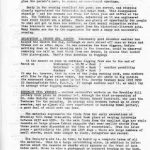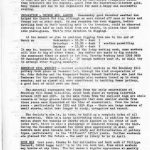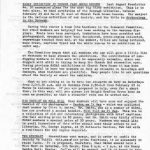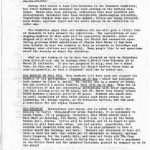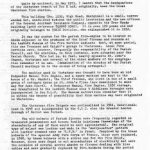The Editor wishes all members a happy New Year. These lines are being written at a time of crisis, with restrictions on heating and lighting. Nevertheless the conventional wish is all the more sincere for it was seldom more necessary than now.
Lectures
The February lecture will be given by Malcolm Colledge “Rome and the East” at the Hendon Library, The Burroughs, NW4 at 8.00 for 8.15p.m. Dr Malcolm Colledge is a lecturer at Westfield College, University of London. He studied Classics at St. John’s College, Cambridge, and has spent several years travelling in Mediterranean and Middle East countries. He has excavated at a Lullingstone Roman Villa and at Petra and Tazekand in Iran. He is a specialist in Roman Art and sculpture; he is also particularly interested in the development of Mediterranean and Middle Eastern civilisation. In 1967 he published “The Parthians” — an account of one of the first Middle Eastern civilisations.
Report on the December lecture on Industrial Archaeology contributed by Alec Jeakins.
Paul Carter chose to examine the premise put forward by R. A. Buchanan that “Industrial Archaeology is at the crossroads” and that after a period of self-analysis it must decide in which direction it is going.
In some parts of the country, industrial archaeology has still not been accepted by many of the county societies, with the result that people interested in this field have formed themselves into local groups which are, as yet, unorganised by any national body. The publications produced by these societies are of a very variable quality, only a few being up to the standard of papers published in the county journals. The Greater London Industrial Archaeology Society (GLIAS) is about to produce its own Journal, and proof pages were on show. As an introduction to the work GLIAS is attempting to carry out, the “Chronicle” film was shown and brought up to date by showing a number of slides. While showing the slides, Paul Carter attempted to open the audience’s eyes to the industrial remains that are all around. He also pointed out the dangers of over-selection, using the example of two original diesel-electric locomotives that came into service in 1947; at the end of their life British Rail tried to give these important locomotives to various preservation societies, but because these engines were not stream-driven nobody was interested and they were then surely sold for scrap.
The final item of the lecture was the showing of the “Abbey Mills Pumping Station” made by Dennis Smith and a team from West Ham Technical College. This was a magnificent example of the right media being used for the right job; no number of still photographs and plans can really give a true impression of a pumping station at work.
N.B. Our own industrial archaeology project still needs help us. Some of the areas the organisers are hoping to look at in the early stages are the remains of farming in the Borough, the aircraft industry around Hendon and along the Edgware Road, and the hospitals. If you want to help with these projects and others please contact Alec Jeakins.
Christmas Party
Whereas it would be difficult, if not impossible, to mention individually all those who worked very hard to achieve the friendly evening that was enjoyed by many, the Editor feels that Richard Deacon should be thanked for his stage-managing of the overall arrangements, Joan Bird for her responsibility for catering and Dorothy Newbury for her successful Tombola that raised £15 for the Society’s funds.
Page 2
One of the party guests contributes the following: —
The HADAS Christmas party was held on 14 December at 166 Station Road, Hendon, festively decorated for the occasion by Eric Grant. A postcard picture of an “antiquity” was pinned on each guest on arrival, plus the person’s name, to ensure conversational openings.
Early in the evening excellent hot punch was served, and everyone clearly appreciated the delectable and ample food. This disappeared steadily — and the company was ready for mince pies and coffee at the end. The Tombola was a huge success, especially as it was engineered that every ticket won a prize. There was plenty of opportunity for people to chat and get to know new members, so that social relaxation rather than brain work was the keynote, apart from the historical-literary quiz. Many thanks are due to the organisers for such a happy and successful evening.
Excavation – Church End Hendon
Reasonably good December weather has helped to the Church End dig, although we were rained off once or twice and frozen out on other days. On one occasion two keen diggers, before settling down on their kneeling mats in the trenches, could be observed removing ice half an inch thick from one trench, in pieces that looked like to plate-glass. That’s true devotion to digging!
At the moment we plan to continue digging from now on to the end of March on Wednesdays 10.30 to dusk, Saturdays 10.00 to dusk and Sundays 10.00 to dusk weather permitting. It may be however that in view of the three-day working week, some members will like to dig at other times. Any member who wants to dig outside the announced times is asked to let Mrs. Dorothy Newbury know. If enough members want it, we shall try to arrange other digging sessions.
Brockley Hill Weekends
Another successful work-in on the Brockley Hill Pottery took place on December 1-2, through the kind co-operation of Mr John Enderby and the Hampstead Garden Suburb Institute, who lent the Teahouse for the occasion. On average nine members turned up to every session, and as almost all were experienced in handling of Roman pottery, a good deal of solid work was done.
The material represents the finds from the early excavations at Brockley Hill Roman kiln-site, which took place at varying intervals between 1937 and 1954. In the main, finds from the earliest digs are all vessels and large pieces (which suggests that some smaller sherds from these years were discarded at the time of excavation). From the later years — particularly the 1953 and 1954 digs — there are large numbers of small sherds, which take longer to study, categorise and record.
The Society’s aim is, in time, to build up a complete index of all the material. This is a large undertakings since, in addition to information about the vessels or sherds which appears on the front of each index card, there is also a photograph or measured drawing on the back. During the December weekend the index grew appreciably in size and members made good inroads into the study and differentiation of pottery types, particularly in the “difficult” 1953-4 years. Further weekends are planned for the future — the next is likely to be in April.
Book Box
Last year, thanks to the initiative and hard work of Philippa Bernard, HADAS began building up its own book box, from which members may borrow at any time. The box makes a regular appearance at monthly meetings during the winter. Mrs. Bernard, having got the venture off the ground, is now handing over responsibility to George Ingram, one of keenest diggers and research workers, who has kindly agreed to act as the Society’s Librarian for an experimental period. Members have been generous in donating books to the box which, as a result, is rapidly assuming the proportions of a small library. Indeed, so weighty is the box itself that Mr Ingram does not propose to bring the whole collection to each monthly lecture.
Page 3
Instead, he will show a selection of the more popular volumes plus a full list of the books now owned by HADAS. Members can then reserve any book which is not on show. And should you want an archaeological book which you suspect may be in the box, don’t forget that a phone call to Mr Ingram will tell you whether or not it is available.
HADAS exhibition at Church Farm House Museum
Last August Newsletter No. 30 announced plans for the next big HADAS exhibition. This is to take place, by kind invitation of the Borough Librarian, between February 23rd and March 31st next at Church Farm House Museum. The subject is the various activities of our society, and the title is “Archaeology in the Borough”.
During this winter a team (its backbone is the Research Committee, but other members are helping) has been working on the various displays. Moats have been surveyed, tombstones have been scrubbed and photographed, documents have been deciphered, photo-copies collected, engravings tracked down and, at the moment, titles are being lettered, maps drawn, captions typed and the whole run-up to an exhibition is under way.
The Committee hopes that all members who can, will give a little time at Weekends to help steward the exhibition. The contribution of non-digging members to this work will be it especially valuable, since our diggers will still be trying to keep the Church End excavation open. During previous HADAS exhibitions at Church Farm House it has been very helpful to have two members on duty as stewards on Saturdays and Sundays, when visitors are plentiful. Many people like to ask questions about the Society or about the exhibits.
What we are aiming at is to have to steward on duty on Saturdays from 2.00-5.30p.m. and on Sundays from 2.30-6.00 from February 23rd to March 31st inclusive. If you are prepared to help, even for a short time, in this way, will you please let a Brigid Grafton Green know as soon as possible, so that a stewards rota can be worked out.
New booklet on Mill Hill
Many members will have seen and enjoyed the booklet of old photographs — “Hendon as it was” — which was published last summer by Clive R. Smith. Mr Smith, a member of HADAS, has now produced a second booklet, “Mill Hill as it was”. This too is a collection of old and interesting photographs with brief captions. Its full selling price is £0.65, but Mr Smith very kindly offers HADAS members a special price of £0.50. Members who would like to avail themselves of this offer should send their orders to our Librarian, Mr George Ingram with a remittance for the copies required.
The Minimart
Excavations cost money, and in order to enable the Society to fulfil this, one of our prime functions, it is necessary to raise funds. It is proposed, therefore, that HADAS should hold a Mini Mart on Saturday 6 March from 9.00a.m. to 1.00p.m. at the Henry Burden Hall, Hendon. Coffee will be served, and it is hoped to have stalls to sell your home-made cakes, jams and sweets; paperbacks, old records and unwanted odds and ends. It is also proposed to have a notice board for Exchange and Mart. Members are entreated to bear all this in mind and make that extra pot of marmalade in January, salvage their Penguins for the Jumble Sale, and turn out to the old 78s from the attics. The Unwanted mink or Rolls Royce may well find a purchaser on the Notice Board and the unwanted Christmas present be snapped up on the stall!
Details will follow in the February Newsletter, but do write the date in your diary now.
Contributed by Daphne Lorimer.
Page 4
Whetstone Fire Station – preliminary note
Daphne Lorimer sent us this report:
Quite by accident, in May 1973, I learnt that the headquarters of the Whetstone branch of Toc H had, originally, been the local Whetstone fire station.
This building (No. 1232, High Road, Whetstone) is a small, narrow wooden hut, sandwiched between the public lavatories and the new offices of the General Accident Insurance Company, opposite the Ever Ready building (grid reference TQ2648 9390). It is over 120 years old and originally belonged to 35HIX Division, who relinquished it in 1932.
It was the custom for the parish fire-engine to be located in sheds adjacent to the premises of the Chief Fireman and records at Lambeth Museum on the Fire Service indicated that, at some period, this was Trounsen and Knight’s garage in Whetstone. Local Fire Services were, however, frequently the responsibility of the Parish Council, and the stations, in this instance, were situated near the Parish Church. This hut is, in fact, nearly opposite St. John’s Church, Whetstone and several of the older members of the congregation remember it in use. (Examination of the minutes of the Parish Council meetings is in the course of being arranged.)
The machine used in Whetstone was thought to have been an old Bedposter Manual Fire Engine, and a spare machine was kept in the house of a Mr. Randell, the Chief Fireman, who lived in one of the small group of cottages known as St. John’s Close (now demolished to make way for Swan Court). A Bedposter Manual Fire Engine, 1930 vintage, was transferred to the Lambeth Museum when 9 Middlesex boroughs were incorporated in the GLC. The Museum authorities consider that it is within the bounds of possibility that this machine may have originated in Whetstone.
The Whetstone Fire Brigade was nationalised in 1941, denationalised in 1948 and incorporated in the GLC went the Greater London Borough of Barnet was formed.
The old helmets of Parish firemen were frequently regarded as treasured possessions and became family heirlooms (knowledge of the whereabouts of any of them would be much appreciated). The original type of helmet was leather and made in the “merryweather” pattern with leather crossed axes or L.F.B. in front. Inspired by the brass helmets of the special Army Fire Corps of France, these were replaced, in 1868, by brass helmets with a silver one for the Fire Chief. However, these were found to act as conductors of electricity and were the occasion of several severe shocks to firemen dealing with live cables and were gradually replaced by fire helmets during the period between 1936-1939.
It is hoped that, as well as an examination of the Parish Records, the scrutiny of contemporary issues of the local press will reveal more information and, possibly, sketches and photographs of the Whetstone Fire Brigade in action.
This newsletter has been edited by Christina Arnott.

